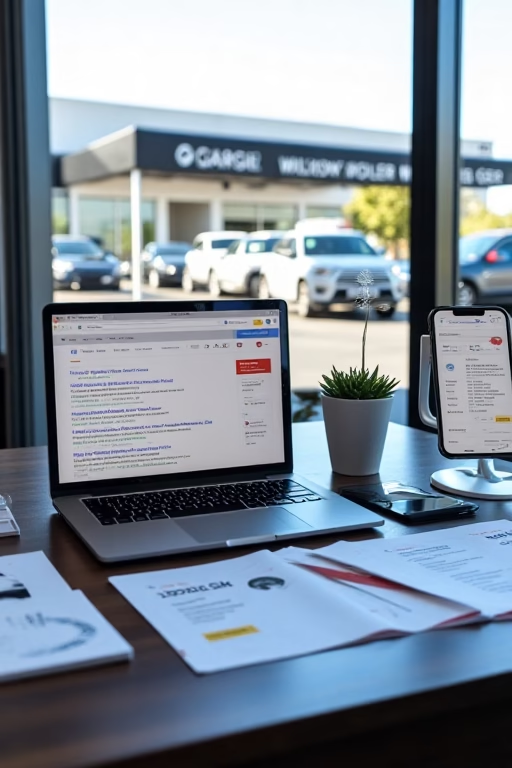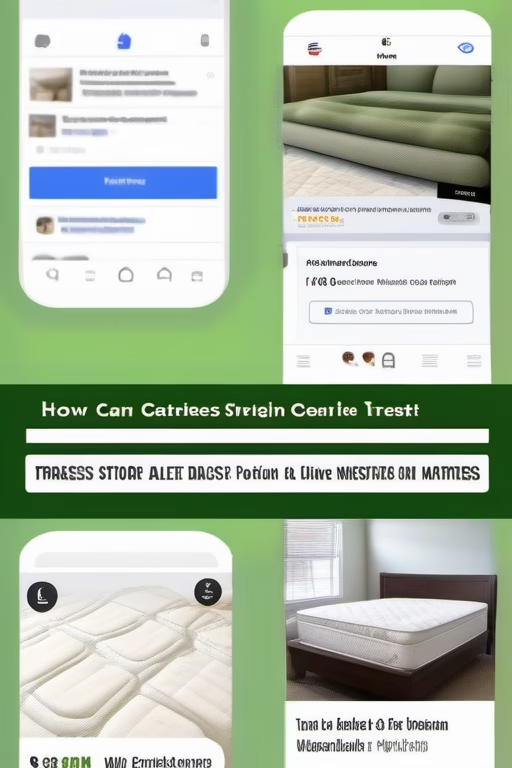How to Sell More Cars with SEO: Ranking Your Dealership on Google
Your Ultimate SEO Playbook by Market Wiz
Table of Contents
- Introduction: The Role of SEO in Auto Sales
- 1. Why SEO Matters for Dealerships
- 1.1 Organic vs. Paid Traffic
- 1.2 Long-Term Value of Ranking
- 2. Keyword Research & Strategy
- 2.1 Targeting Model & Make Terms
- 2.2 Local & Long‑Tail Keywords
- 2.3 Competitor Gap Analysis
- 3. On‑Page Optimization
- 3.1 Title Tags & Meta Descriptions
- 3.2 Header Tags & Content Structure
- 3.3 Image Alt Text & Schema Markup
- 4. Technical SEO Essentials
- 4.1 Site Speed & Mobile‑First
- 4.2 XML Sitemaps & Robots.txt
- 4.3 Secure HTTPS Implementation
- 5. Local SEO for Dealerships
- 5.1 Google Business Profile Optimization
- 5.2 Local Citations & Reviews
- 5.3 Local Content & Landing Pages
- 6. Content Marketing & Blogging
- 6.1 Vehicle Comparison Guides
- 6.2 Buyer’s Roadmap & FAQ Pages
- 6.3 Video & Infographic Integration
- 7. Link Building Strategies
- 7.1 Community Partnerships & Sponsorships
- 7.2 Industry Directories & Press
- 7.3 Content‑Driven Outreach
- 8. User Experience & Conversion Optimization
- 8.1 Easy Navigation & Search
- 8.2 Mobile‑Friendly Forms
- 8.3 Clear Calls‑to‑Action
- 9. Analytics, Tracking & Reporting
- 9.1 Google Analytics Goals
- 9.2 Search Console Insights
- 9.3 KPI Dashboards
- 10. Essential SEO Tools & Plugins
- 11. Real‑World Dealership Case Studies
- Conclusion & Next Steps
- 25 Frequently Asked Questions
- 25 Extra Keywords
Introduction: The Role of SEO in Auto Sales
In today’s digital showroom, ranking on Google can drive a flood of high‑intent car shoppers to your dealership. Unlike fleeting PPC clicks, strong organic positions deliver sustainable traffic, credibility, and ultimately—more sold units. In this guide, Market Wiz shares a comprehensive SEO framework to elevate your auto dealership above the competition.
1. Why SEO Matters for Dealerships
1.1 Organic vs. Paid Traffic
Organic clicks command higher trust and lower long‑term cost per lead than paid ads. As consumers skip past the ads to click on top organic results, being there matters.
1.2 Long-Term Value of Ranking
Once you achieve top positions for lucrative keywords like “2025 Toyota Camry near me,” that visibility compounds month after month—fueling consistent showroom visits.
2. Keyword Research & Strategy
2.1 Targeting Model & Make Terms
Focus on high‑volume terms like “[Make] [Model] for sale” paired with your city. Use tools like Ahrefs or SEMrush to identify search volumes.
2.2 Local & Long‑Tail Keywords
Capture intent with “best financing deals in [City]” or “certified pre‑owned SUVs [ZIP code]” to reach buyers ready to act.
2.3 Competitor Gap Analysis
Analyze rival dealer sites to uncover keywords they rank for but you don’t—then create content to fill those gaps.
3. On‑Page Optimization
3.1 Title Tags & Meta Descriptions
Include primary keywords and local modifiers in titles (under 60 characters) and craft compelling descriptions to boost click‑throughs.
3.2 Header Tags & Content Structure
Use H1 for page topic (“2025 Honda Civic for Sale in Denver”), H2s for subtopics, and keep paragraphs concise for readability.
3.3 Image Alt Text & Schema Markup
Optimize vehicle images with descriptive alt tags and implement Product and LocalBusiness schema to enhance SERP features.
4. Technical SEO Essentials
4.1 Site Speed & Mobile‑First
Compress images, leverage browser caching, and use a responsive theme to ensure pages load under 3 seconds—critical for both users and Google.
4.2 XML Sitemaps & Robots.txt
Submit an up‑to‑date sitemap to Search Console and configure robots.txt to guide crawlers only to your important pages.
4.3 Secure HTTPS Implementation
Switch your site to HTTPS to protect user data and gain the slight ranking boost Google awards secure sites.
5. Local SEO for Dealerships
5.1 Google Business Profile Optimization
Claim and fully optimize your GBP: accurate NAP, categories, photos, and regular posts about promotions or reviews.
5.2 Local Citations & Reviews
Ensure your dealership’s name, address, and phone are consistent across directories (Yelp, YellowPages) and actively solicit Google reviews.
5.3 Local Content & Landing Pages
Create city‑specific pages (e.g., “Used Trucks in Austin”) with unique content highlighting local inventory and offers.
6. Content Marketing & Blogging
6.1 Vehicle Comparison Guides
Publish in‑depth comparisons (“Camry vs. Accord”) to capture research‑phase traffic and build authority.
6.2 Buyer’s Roadmap & FAQ Pages
Guide prospects through financing, trade‑in, and leasing FAQs—answering questions they search for.
6.3 Video & Infographic Integration
Embed walk‑around videos and infographics (e.g., “5 Steps to Buy a Car”) to boost dwell time and shareability.
7. Link Building Strategies
7.1 Community Partnerships & Sponsorships
Sponsor local events or charities and request a backlink from the event page.
7.2 Industry Directories & Press
List your dealership on reputable auto industry directories and issue press releases for new model launches.
7.3 Content‑Driven Outreach
Promote your comparison guides and market reports to auto blogs and local news sites for natural links.
8. User Experience & Conversion Optimization
8.1 Easy Navigation & Search
Implement faceted search for filters by make, model, price, and body type to help users find the right car quickly.
8.2 Mobile‑Friendly Forms
Simplify finance quote and contact forms for one‑page mobile completion to reduce abandonment.
8.3 Clear Calls‑to‑Action
Use prominent buttons like “Schedule Test Drive,” “Apply for Financing,” and “Value My Trade” above the fold.
9. Analytics, Tracking & Reporting
9.1 Google Analytics Goals
Set up Goals for form submits, phone clicks, and brochure downloads to measure lead generation.
9.2 Search Console Insights
Use Search Console to track keyword positions, impressions, and click‑through rates for ongoing SEO tuning.
9.3 KPI Dashboards
Create a dashboard combining organic traffic, lead volume, and SERP rankings to demonstrate SEO ROI.
10. Essential SEO Tools & Plugins
- Ahrefs or SEMrush for keyword & backlink analysis
- Google PageSpeed Insights for speed audits
- Yoast SEO or Rank Math plugin for WordPress on‑page guidance
- LocalFalcon for local rank tracking
- Screaming Frog for technical crawling
11. Real‑World Dealership Case Studies
One Midwest dealer increased organic leads by 85% year‑over‑year by launching city‑targeted landing pages and optimizing their GBP. Another luxury showroom doubled test‑drive requests by publishing monthly video reviews and securing backlinks from local lifestyle blogs.
Conclusion & Next Steps
Mastering SEO is a marathon, not a sprint—but the rewards are dealership‑filling. Start with solid keyword research, nail your on‑page basics, and layer in local optimizations. Build content that answers buyer questions and earn credible links to boost authority. With diligent tracking and continuous refinement, you’ll rank higher, attract qualified shoppers, and ultimately—sell more cars.
25 Frequently Asked Questions
1. How long until I see SEO results?
Typically 3–6 months for significant ranking improvements, though technical fixes can yield quicker wins.
2. Do I need separate pages for each model?
Yes—individual pages allow you to target model‑specific keywords and provide detailed specs.
3. How many keywords per page?
Focus on one primary keyword and 3–5 related secondary terms naturally throughout the content.
4. What’s the top local ranking factor?
Your Google Business Profile signals—complete info, reviews, and local citations are critical.
5. How important are reviews?
Very—review quantity and sentiment influence both local pack placement and user trust.
6. Can I do SEO myself?
With time and the right tools, yes—but a professional can accelerate results and avoid pitfalls.
7. How often update my content?
Refresh key pages quarterly and blog weekly to maintain relevance and rankings.
8. What’s schema markup?
Structured data that helps search engines understand your pages and display rich results like star ratings.
9. How do I track mobile vs. desktop rankings?
Use rank‑tracking tools that differentiate device types, such as Ahrefs’ mobile vs. desktop reports.
10. Should I block low‑value pages?
Yes—use noindex for paginated or duplicate pages to concentrate crawl budget on your priority content.
11. How many backlinks do I need?
Quality over quantity—a few high‑authority, relevant links can outperform dozens of low‑value ones.
12. What is “E‑A‑T”?
Expertise, Authoritativeness, Trustworthiness—a Google quality guideline that emphasizes credible content.
13. How do I optimize images?
Compress file size, use descriptive alt text with keywords, and include images in an XML sitemap if large.
14. What’s the ideal page length?1,000–1,500 words for in‑depth model pages; longer (2,000+ words) for comparison and guide content.15. How do I handle out‑of‑stock models?
Keep pages live with back‑order info or suggest similar models to preserve SEO value.
16. Should I use HTTPS?Yes—HTTPS is both a ranking factor and essential for user trust during credit applications.17. How often audit my site?Perform a full technical SEO audit at least twice a year and spot‑check key issues monthly.18. Can social media impact SEO?
18. Can social media impact SEO?
Indirectly—social shares can drive traffic and awareness, leading to natural backlinks.
19. What’s a good bounce rate?
Aim for under 60% on model pages; lower (~40–50%) indicates strong engagement.
20. How to fix crawl errors?Use Google Search Console to identify 404s or server errors, then redirect or correct the links.21. Do I need a blog?Absolutely—regular blog posts let you target long‑tail queries and showcase dealership expertise.22. How to optimize for “near me” searches?
22. How to optimize for “near me” searches?
Include “near me” and city names in your content and ensure your GBP is fully optimized.
23. What’s mobile‑first indexing?Google primarily uses the mobile version of content for indexing and ranking—mobile optimization is essential.24. How do I improve click‑through rate?Write enticing meta descriptions and use structured snippets (pricing, reviews) to stand out.25. What’s the first step?Perform a baseline audit—identify technical issues and priority keywords, then build your SEO roadmap.
25. What’s the first step?Perform a baseline audit—identify technical issues and priority keywords, then build your SEO roadmap.
25 Extra Keywords
- dealership SEO strategy
- car dealership local SEO
- auto dealer Google ranking
- model‑specific keyword targeting
- long-tail automotive keywords
- dealership schema markup
- mobile-first SEO auto
- Google Business Profile cars
- auto dealership citations
- vehicle comparison SEO
- SEO for test drive bookings
- automotive link building
- dealership content marketing
- schema Product automotive
- HTTPS for car dealers
- XML sitemap cars
- dealership website speed
- SEO audit tools auto
- SEO reporting for dealerships
- car classifieds SEO
- SEO for used cars
- local search “car dealer near me”
- SEO plugin WordPress auto
- dealer press release SEO
- Market Wiz auto SEO guide

















